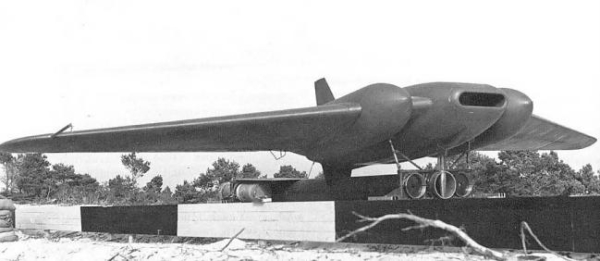
| ||||
|---|---|---|---|---|
 |
 |
 |
 |
 |



























| ||||
|---|---|---|---|---|
 |
 |
 |
 |
 |


























Northrop JB-1 "Bat" (N-16, MX-543)
Jet-powered flying wing surface-to-surface cruise missile


Overview [1]
The Northrop JB-1 "Bat" or "Thunderbug" was a United States Army Air Force surface-to-surface jet-powered flying wing cruise missile.
The United States Army Air Forces Jet Bomb program had its origins in August 1942 when a crashed Fi-103 better known as the "V-1", was found on the Danish island of Bornholm. The Fi-103, code named Flakzielgeröt-43 (FGZ-43), led to an American effort in 1943 to develop an equivalent weapon. Prior to the jet bomb program Northrop had contracted under Project MX-334 for a small rocket propelled flying wing aircraft. The MX-334 had first flown as a glider on November 9, 1943. It flew under rocket power on July 5th 1944.
Northrop formally contracted with the Army Air Force for the jet bomb MX-543 project on July 1, 1944, shortly after the Germans began their "V-1" campaign against England. Progress was rapid as much design work and plans were picked up directly from the work done on MX-334. The first JB-1 prototype (glider) was built as a manned glider to test the flight characteristics of the vehicle at lower speeds. This was a typical approach by Northrop due to its lack of a wind tunnel. The first flight of the JB-1 (glider) was piloted by Harry Crosby on August 27, 1944. The General Electric B-1 turbojet engine was an attempt to create a small turbojet from a B-31 turbosupercharger. The man behind it was GE Manager of Test Gene Stoeckly. Because his parents were foreign nationals he was prohibited from working on GE’s secret project to adapt the Power Jets W.1 engine for American production as the GE 1-A, which was developed into the I-16. After a potential customer in the form of Northrop expressed a desire for a small turbojet, development was handed off to Russ Hall and Marty Hemsworth who managed to turn the bootstrap project into ostensibly flight worthy hardware. The JB-1 (bomb) equipped with two GE B-1 engines was ready for testing in early December 1944 at Range 64, Sana Rosa Island, Florida. On December 7th 1944 it was launched and promptly stalled and crashed. The stall was attributed to an improper elevon setting compounded by a failure of one of the GE B-1 turbojets. The Army Air Forces Report on the failure stated "Flight failure was primarily attributted to improper setting of the bombs control surfaces prior to launching, but damage to the right turbo-jet engine approximately 30 seconds before take-off would not have permitted successful flight." The Northrop JB-1 suffered from numerous production and structural complexities as well as being overweight. The problem of persistent turbine failures coupled with the JB-1s low thrust had already caused Northrop to seek another powerplant, the Ford pulse jet as used on the JB-2. That change coupled with the need to reduce the cost of manufacturing the JB-1 led to the development of the JB-10.
Northrop JB-1 "Bat" (MX-543 Bomb) Specifications and Performance Data [2]
References